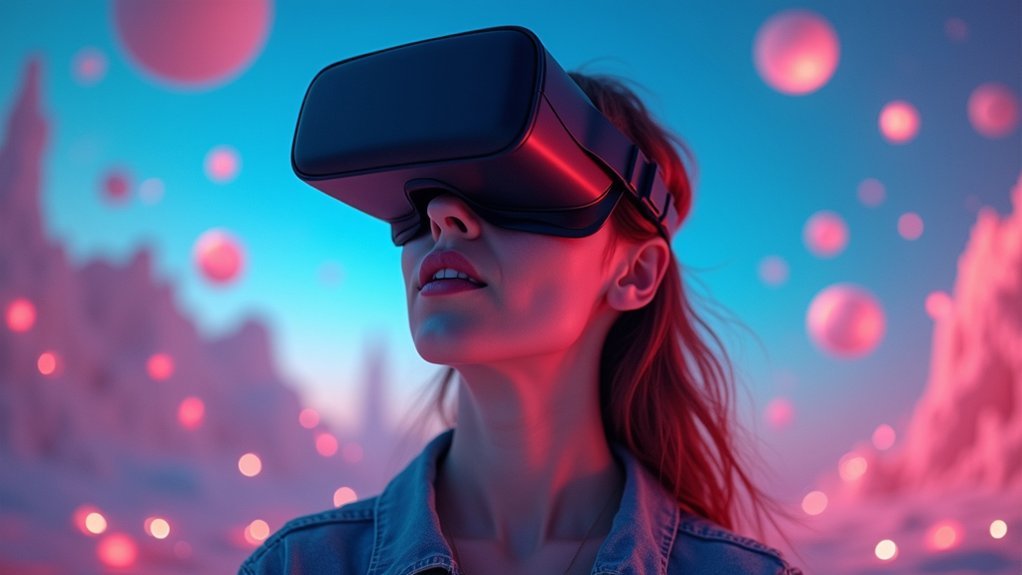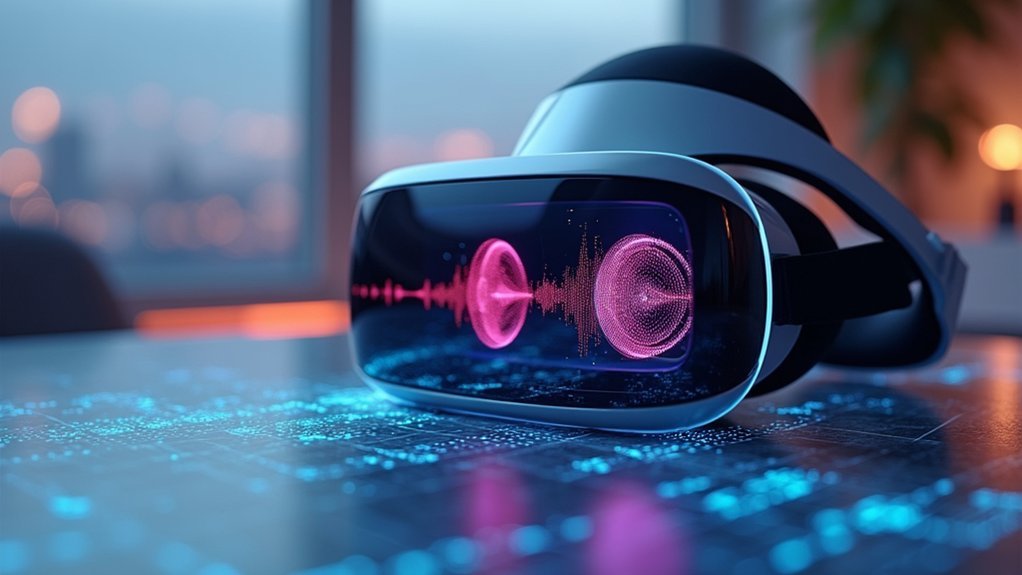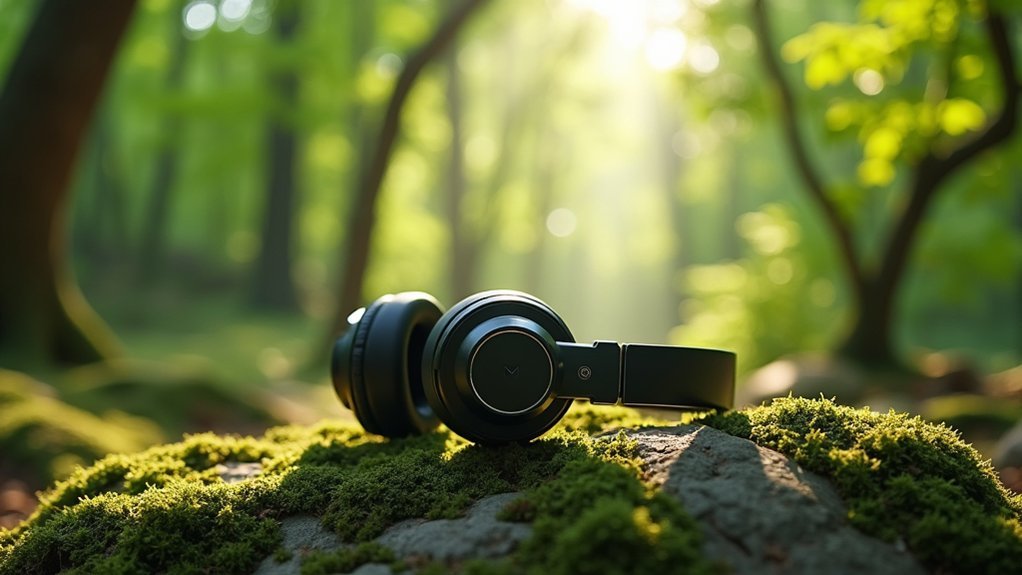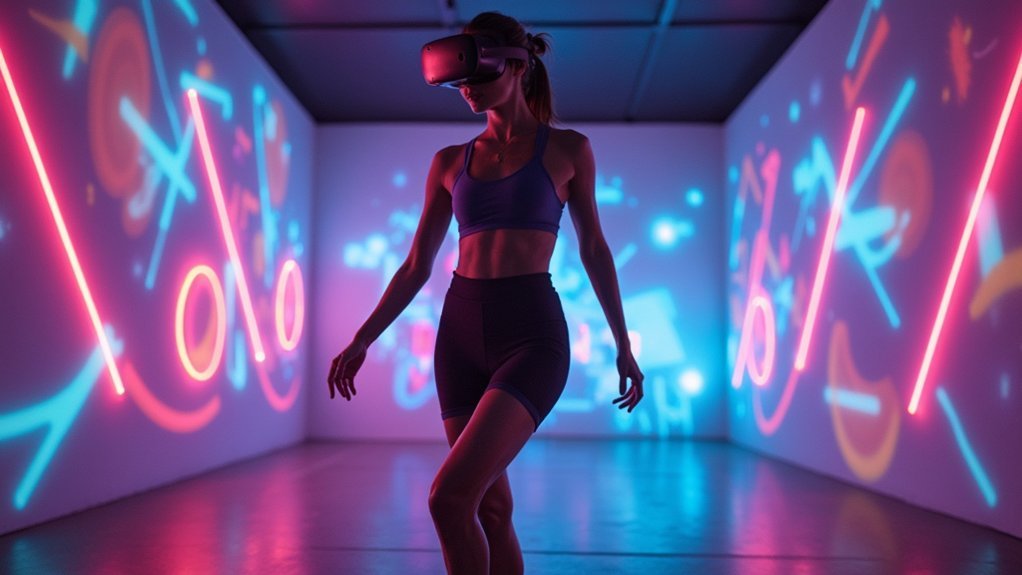You’ll experience a fundamental shift in how your brain processes virtual environments when spatial audio replaces traditional stereo sound with three-dimensional soundscapes that mirror natural human hearing. Unlike conventional audio systems, spatial audio uses Head-Related Transfer Functions and object-based positioning to create realistic sound localization that responds dynamically to your movements. This technology reduces cognitive load while enhancing emotional connections and situational awareness in VR experiences. The implementation strategies ahead reveal how to maximize these transformative benefits.
Understanding Spatial Audio Technology and Its Core Principles

Your ears naturally process sound in three dimensions, detecting not just what you’re hearing but precisely where it’s coming from—and spatial audio technology mirrors this remarkable ability.
Unlike traditional stereo systems, spatial audio creates a full 3D soundscape that transforms your listening into an immersive experience.
Spatial audio revolutionizes traditional listening by creating immersive three-dimensional soundscapes that surround and engage listeners completely.
The technology relies on Head-Related Transfer Functions (HRTFs) to simulate how sound interacts with your unique head and ear shapes. Advanced algorithms enable object-based audio mixing, treating each sound element as an individual object with specific coordinates in three-dimensional space.
This personalized approach differentiates spatial audio from general 3D audio formats. Technologies like Dolby Atmos utilize these precise techniques to create dynamic sound placement, enhancing storytelling and engagement across music, film, and gaming applications.
How Spatial Audio Transforms Virtual Reality Experiences
When you enter a VR environment equipped with spatial audio, you’ll immediately notice how sounds appear to come from specific locations around you, creating a convincing illusion that you’re truly present in that virtual space.
You’ll experience gaming audio that responds dynamically to your movements, with footsteps, explosions, and ambient sounds shifting naturally as you turn your head or change position.
This real-time head tracking guarantees that audio sources maintain their spatial relationships, so you can close your eyes and still accurately pinpoint where sounds originate within the virtual world.
Enhanced Spatial Sound Localization
Two essential elements define exceptional virtual reality experiences: visual immersion and spatial audio precision. Enhanced spatial sound localization transforms how you perceive virtual environments by using Head-Related Transfer Functions (HRTFs) to simulate realistic audio interactions with your ears. This immersive sound experience enables you to accurately pinpoint sound sources, dramatically improving situational awareness in gaming and simulations.
| Audio Technology Feature | Traditional Audio | Spatial Audio |
|---|---|---|
| Sound Localization | Fixed stereo channels | Dynamic 3D positioning |
| Cognitive Load | Higher distraction | Reduced mental effort |
| Emotional Connection | Limited engagement | Enhanced immersion |
| Directional Accuracy | Poor spatial cues | Precise sound placement |
| Real-world Simulation | Artificial feeling | Natural audio interactions |
Advanced sound design through spatial audio reduces cognitive load while fostering emotional connections, making virtual environments feel authentically three-dimensional.
Immersive Gaming Audio Integration
How does spatial audio revolutionize your virtual reality gaming experience?
You’ll discover that object-based audio technology creates dynamic soundscapes where you can hear sounds from above, below, and all around you. This dramatically deepens your sense of presence in virtual environments.
When you’re playing tactical games like Call of Duty or Fortnite, spatial audio lets you pinpoint exactly where footsteps or gunfire originate, giving you a significant competitive advantage.
Next-gen headsets like the Meta Quest Pro deliver this realistic auditory experience through integrated spatial audio systems.
You’ll notice improved situational awareness as detailed sound cues guide your gameplay decisions.
Research shows that immersive gaming with spatial audio increases your emotional engagement, making you feel genuinely connected to virtual storylines and environments.
Real-Time Head Tracking
As you turn your head in a virtual reality environment, real-time head tracking technology seamlessly adjusts audio positioning to match your natural movements.
Your device’s internal accelerometers and gyroscopes constantly monitor head orientation, dynamically repositioning sounds in your 360-degree environment. This creates authentic spatial audio experiences where you’ll hear footsteps approaching from behind or engines roaring overhead exactly where they’d occur naturally.
When you’re gaming, real-time head tracking enhances situational awareness dramatically.
You’ll pinpoint enemy locations, detect environmental hazards, and navigate complex scenarios with greater precision. This technology reduces cognitive load while amplifying engagement, making virtual worlds feel genuinely responsive.
The combination transforms immersive experiences from simple audio playback into realistic soundscapes that react instantly to your movements, creating unparalleled authenticity in virtual environments.
Key Features of Spatial Audio SDKs for VR Development
Several essential features define modern spatial audio SDKs and set them apart as powerful tools for VR development. These platforms deliver immersive sound experiences through sophisticated processing techniques that transform how you perceive virtual environments.
You’ll find advanced Head-Related Transfer Functions (HRTFs) that create realistic 3D soundscapes, making virtual worlds feel genuinely three-dimensional.
Key capabilities that enhance your VR projects include:
- Object-based audio positioning – You can place individual audio objects precisely within three-dimensional space, giving you complete control over sound placement and movement.
- Real-time head tracking integration – Your VR headsets automatically adjust audio based on head position changes, maintaining consistent spatial relationships.
- Cross-platform compatibility – Popular SDKs like Dolby Atmos seamlessly integrate across various VR devices, ensuring consistent experiences regardless of hardware.
Benefits of Implementing Spatial Audio in VR Applications

Implementing spatial audio in your VR applications transforms user experiences through dramatically enhanced immersion and engagement. You’ll create authentic 3D environments where users pinpoint audio sources with precision, making virtual interactions feel natural. HRTFs personalize sound based on individual ear shapes, delivering tailored immersive audio experiences.
| Benefit | Impact |
|---|---|
| Enhanced Immersion | Users feel truly present in virtual spaces |
| Improved Engagement | Increased cognitive presence in training scenarios |
| Emotional Connections | Stronger emotional responses through realistic soundscapes |
| Natural Interactions | Real-time audio adjustments with head tracking |
| Educational Effectiveness | Better learning outcomes in virtual environments |
Your applications gain competitive advantages through deeper emotional responses and storytelling capabilities. Users become emotionally invested when surrounded by authentic acoustics that mirror real-world environments, creating memorable experiences that keep them returning.
Comparing Spatial Audio Solutions for Different VR Platforms
When you’re selecting a VR headset, you’ll find that each platform implements spatial audio differently, with unique technologies that directly impact your immersive experience.
You’ll notice significant variations in sound quality, processing power, and integration capabilities across devices like the Meta Quest series, HTC VIVE XR Elite, Pico 4, and Varjo VR-3.
Understanding these platform-specific differences and their performance benchmarks will help you choose the right headset for your specific VR applications and use cases.
Platform-Specific Audio Technologies
How do different VR platforms approach spatial audio, and which solution best serves your immersive experiences? Each platform implements unique platform-specific audio technologies that cater to distinct use cases and performance requirements.
Meta Quest devices excel in gaming and collaboration through intuitive sound localization, while HTC VIVE XR Elite and Pico 4 deliver dynamic soundscapes that respond to your movements.
Varjo VR-3 combines high-fidelity spatial audio with professional-grade visuals for training simulations.
Consider these key factors when evaluating platforms:
- Audio Processing Power – Hardware capabilities determine object-based audio complexity and real-time rendering quality.
- Developer Ecosystem – Third-party solutions like Agora and Conquest VR expand platform capabilities beyond native offerings.
- Content Integration – Platform compatibility with immersive titles affects your overall audio experience quality.
Performance Benchmarking Analysis
Since spatial audio performance varies dramatically across VR platforms, you’ll need concrete benchmarking data to make informed decisions about which solution delivers the most compelling immersive experience for your specific use case.
Performance benchmarking reveals significant differences in spatial audio capabilities across leading VR headsets. Meta Quest Pro and Quest 2 excel at directional sound simulation, while HTC VIVE XR Elite provides superior sound localization for interactive applications.
Pico 4’s Dolby Atmos support enables dynamic audio experiences that respond to user movement, and Varjo VR-3 offers precise sound placement for professional training simulations.
Studies consistently show that high-quality spatial audio systems dramatically increase user satisfaction rates. You’ll experience improved immersion and enhanced cognitive performance compared to traditional audio setups, making spatial audio a critical factor in platform selection.
Integration Process for Spatial Audio SDKs in VR Projects

Three critical steps define the integration process for spatial audio SDKs in VR projects, starting with selecting the right SDK for your target platforms and devices.
You’ll need to choose between options like Dolby Atmos or Unity’s built-in audio features based on compatibility requirements.
Next, you’ll configure audio sources to utilize 3D properties within your virtual environment. This involves implementing Head-Related Transfer Functions (HRTFs) and positioning sound objects accurately in space to create truly immersive experiences.
- SDK Selection & Documentation Review – Choose compatible spatial audio frameworks and study implementation guidelines thoroughly
- 3D Audio Configuration – Set up HRTF-based sound positioning for realistic spatial placement
- Cross-Platform Testing – Evaluate audio performance across different devices and playback systems
Collaborating with experienced sound designers optimizes your integration process considerably.
Performance Optimization Techniques for Spatial Audio in VR
While spatial audio enhances immersion in VR experiences, maintaining ideal performance requires strategic resource management to prevent audio processing from compromising your target 90 FPS threshold.
You’ll achieve peak performance optimization by implementing object-based audio systems that dynamically process only sounds relevant to your position, considerably reducing CPU overhead.
Integrate Head-Related Transfer Function algorithms to enhance localization accuracy without overwhelming processing power, ensuring minimal latency for immersive experiences.
HRTF algorithms deliver precise audio positioning while preserving computational efficiency, creating seamless VR experiences with minimal processing overhead.
Consider leveraging audio middleware solutions like Wwise or FMOD to streamline spatial audio implementation while managing complex VR environments efficiently.
These tools simplify resource allocation and feature integration. Regular profiling across various scenarios helps identify bottlenecks, ensuring your spatial audio remains responsive and immersive regardless of hardware configuration, maintaining seamless performance throughout diverse virtual environments.
Real-World Applications of Spatial Audio Across VR Industries
You’ll find spatial audio transforming industries far beyond traditional entertainment, creating tangible benefits across healthcare, training, and accessibility sectors.
These applications demonstrate how precise sound positioning isn’t just about immersion—it’s about solving real-world challenges and improving outcomes for users with diverse needs.
Let’s examine how gaming environments, medical solutions, and professional training programs are leveraging spatial audio to revolutionize their respective fields.
Gaming and Entertainment Applications
How does spatial audio transform your gaming and entertainment experiences from ordinary to extraordinary?
You’ll discover that this technology revolutionizes how you perceive and interact with digital content across multiple platforms.
In gaming, spatial audio provides precise sound localization that lets you detect enemy movements and environmental cues with remarkable accuracy.
Popular titles like Call of Duty and Fortnite demonstrate how this immersive experience gives you a competitive edge through enhanced situational awareness.
For entertainment, you benefit from:
- Enhanced VR environments – Meta Quest and HTC VIVE platforms simulate real-world sound interactions for authentic experiences
- Dynamic cinematic storytelling – Filmmakers position sound elements three-dimensionally to boost audience engagement
- Richer music streaming – Apple Music and Tidal deliver revolutionary listening experiences that transform audio content interaction
Healthcare and Accessibility Solutions
Beyond entertainment, spatial audio creates life-changing opportunities in healthcare and accessibility applications.
You’ll find immersive soundscapes transforming therapeutic environments, where patients experience reduced stress and enhanced relaxation during treatment. Research shows spatial audio improves your cognitive performance while reducing anxiety in virtual reality wellness programs.
Healthcare professionals benefit from enhanced training simulations that use realistic auditory cues to improve knowledge retention and skill acquisition.
You’ll discover accessibility solutions that revolutionize navigation for visually impaired individuals through directional audio signals that boost spatial awareness.
Projects like PeopleLens demonstrate spatial audio’s potential, helping blind children identify people through sound cues and enhancing social interactions.
These technologies prove that spatial audio extends far beyond entertainment, creating meaningful improvements in quality of life and professional development.
Training and Simulation Benefits
While spatial audio transforms healthcare and accessibility, its impact on professional training and simulation represents another breakthrough application.
You’ll find that spatial audio elevates training simulations by creating authentic sound environments where you can accurately locate sounds from multiple directions. This technology proves essential in flight simulators, emergency response scenarios, and surgical training where sound localization directly impacts your performance and safety.
Three key training advantages include:
- Enhanced situational awareness – You’ll develop better decision-making skills by identifying instrument sounds and environmental cues in medical simulations.
- Improved threat detection – Military VR programs help you locate dangers through precise audio positioning in combat scenarios.
- Natural collaboration – Remote teams experience more effective communication through spatially-placed sound cues that mirror real-world dynamics.
These immersive experiences deliver superior retention and learning outcomes compared to traditional training methods.
Hardware Requirements for Effective Spatial Audio Implementation
Three critical components form the foundation of effective spatial audio implementation: high-quality audio hardware, precise sound reproduction capabilities, and seamless integration with immersive technologies.
You’ll need VR headsets like the Oculus Quest 2 or HTC Vive, which support spatial audio natively for immersive experiences.
Your headphones must offer noise isolation and high-fidelity sound to deliver essential directional cues.
Advanced audio processing technologies, including Head-Related Transfer Functions (HRTFs), customize sound profiles based on your ear shape, improving localization accuracy.
You should invest in devices with accelerometers and gyroscopes, like AirPods Pro, enabling dynamic head tracking for real-time adjustments.
Choose hardware supporting object-based formats such as Dolby Atmos, allowing precise sound placement and movement within 3D spaces for enhanced listening experiences.
Developer Tools and Resources for Spatial Audio SDK Integration
When implementing spatial audio in your applications, you’ll find that modern development platforms offer thorough SDK integration tools that streamline the entire process.
Solutions like Dolby Atmos provide comprehensive developer tools for placing sound objects in 3D environments, while Unity and Unreal Engine deliver built-in spatial audio features through plugins.
Apple’s AVAudioEngine and AudioKit enable dynamic immersive experiences on iOS and macOS using head tracking and HRTF technology.
Key advantages of spatial audio SDKs include:
- Extensive documentation and sample projects that eliminate the need to build advanced audio techniques from scratch
- Cross-platform compatibility ensuring consistent audio experiences across multiple devices and operating systems
- Built-in integration with popular game engines allowing seamless implementation of spatial audio features
Future Innovations in Spatial Audio Technology for Virtual Reality
As virtual reality technology continues to evolve, spatial audio innovations are poised to transform how you’ll experience immersive digital environments.
Next-generation headsets like the Meta Quest Pro and Varjo VR-3 will incorporate advanced tracking systems that respond to your movements in real-time, creating dynamic soundscapes that enhance realism.
You’ll benefit from object-based audio formats such as Dolby Atmos, which precisely place sound elements within a 3D space for truly individualized environments.
These innovations reduce cognitive load and stress during virtual reality sessions, improving your overall wellbeing.
Collaboration between audio firms and VR developers is expanding applications across gaming, training simulations, and therapeutic environments, delivering unprecedented interactive spatial audio experiences that’ll redefine immersive experiences entirely.
Frequently Asked Questions
Why Would You Want Spatial Audio?
You’d want spatial audio because it creates three-dimensional sound that surrounds you, making games and movies feel incredibly realistic. You’ll hear where sounds come from, enhancing your immersion and emotional connection.
What Is the Difference Between Spatial Audio and Immersive Audio?
You’ll find spatial audio focuses on precise three-dimensional sound positioning using advanced algorithms, while immersive audio creates an enveloping experience that includes sounds from above and below for complete auditory engagement.
What Is the Benefit of Apple Spatial Audio?
You’ll experience realistic 3D audio that moves with your head movements, creating immersive soundscapes for music and movies while accessing exclusive Spatial Audio content on Apple Music through compatible devices.
Is Spatial Audio Better Than Dolby Atmos?
You can’t say spatial audio’s definitively better than Dolby Atmos since Atmos is actually a specific type of spatial audio. Dolby Atmos often delivers superior object-based positioning and wider platform compatibility.





Leave a Reply